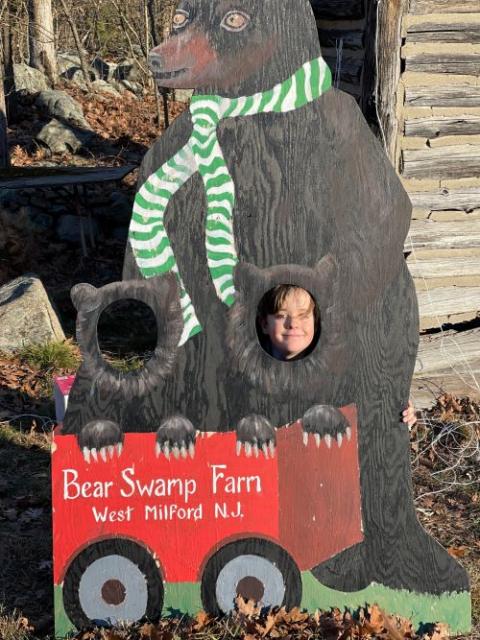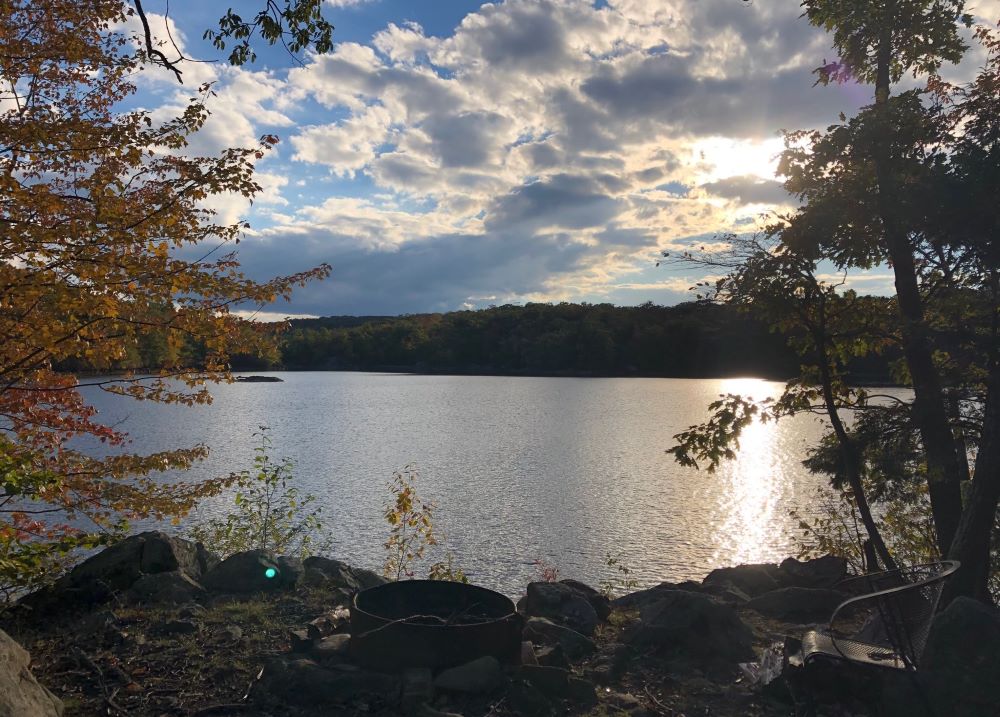
Griffin Hilke stands near a cut Christmas tree Dec. 2 at Bear Swamp Farm in New Jersey, where his extended family harvests 200 to 225 Christmas trees per year. (Chris Hilke)
For the past couple years, my kids have helped to renew an ancient ceremony. We go out to a small Christmas tree farm and wander until a particular tree calls. We pray, make an offering of incense and sprinkle it with holy water. We ask permission and give thanks, treating the tree like a relative that is becoming part of our family. In the process, we become part of its family, too.
The kids jump right in. For them, it's the natural and just response to a life being given for you. It's also a way to process the scale of lives that are given. With at least 25 million Christmas trees harvested in the U.S. each year, there's a lot to think about.
Not surprisingly, some ecologically minded people are hesitant or even opposed to harvesting a Christmas tree. They claim it is better to let all trees stand, and instead of planting domesticated trees, we should let the land return to its "natural" state.

Griffin Hilke poses with a holiday photo prop Dec. 2 at Bear Swamp Farm, where about 9 acres of Christmas trees, along with selective timber harvesting, support about 300 acres of land in its natural state. (Chris Hilke)
Yet there are many reasons to take the idea seriously that cutting down Christmas trees helps the land. It promotes local agriculture. It's less impactful than using artificial trees, which require chemicals to make, fuel to ship, and are typically used for a short time before ending up in a landfill.
I think the best reason to harvest a live Christmas tree is a cultural paradigm shift that Indigenous people are fostering. The most prominent voice, Robin Wall Kimmerer, author of the bestseller Braiding Sweetgrass, makes the radical claim — at least to our contemporary non-Indigenous ears — that harvesting something respectfully actually helps the species, the land and human beings flourish.
For example, without respectful human use, sweetgrass tends to get choked out by other grasses and disappear. Kimmerer and her students demonstrated the presence of sweetgrass in the northeastern U.S. tends to be close to the Indigenous communities that use them. A relationship of reciprocity leads to flourishing.
Trees, of course, are different from grass. Trees take much longer to grow and they don't always grow back by themselves. Yet there's evidence that our demand for Christmas trees is shaping the land in positive ways. One of my neighbors helped me to see this.
Bear Swamp is one example, but there are many ways to better engage with the land through the Christmas tree tradition.
Chris Hilke is the Northeast director for Coastal Resilience at the National Wildlife Federation. He is also the forest manager for Bear Swamp Farm, a choose-and-cut Christmas tree farm in New Jersey.
To say that the property is unique is an understatement. Located 30 miles from New York City, this island of forest in the concrete sea of northern New Jersey is its own watershed.
Chris introduced me to his wife's aunt Allison Hosford, who manages Bear Swamp and runs an organic farm on the adjacent property. Her grandparents spent 10 years cobbling together the tract by buying up adjacent lots to prevent development.
"There were at least 20," she said. "They wanted to protect not only the lake but the entire watershed. Their intention was to create a place where their children, and many generations into the future, could enjoy the land and come to know and love each other."
But with suburban growth skyrocketing around them came a new economic reality. "Property taxes started escalating to a crisis point in the '60s," said Allison, "and suddenly we were going to lose it all really fast if we didn't do something."
In 1964, New Jersey passed the Farmland Assessment Act, which "permits farmland and woodland acres that are actively devoted to an agricultural or horticultural use to be assessed at their productivity value."
"A combination of sustainable timber harvesting and Christmas trees meant that we could pay one-tenth the taxes," Allison said.

This lake is on the property of Bear Swamp Farm, seen Oct. 20, 2018. Allison Hosford said her grandparents bought "at least 20" adjacent lots of land because "They wanted to protect not only the lake but the entire watershed." (Chris Hilke)
The Hosford family started planting a couple hundred Christmas trees each year, using rocky, poor soil around ledges. In the 1980s, they became more intentional and increased to 1,000 to 2,000 trees.
"The whole extended family works together to harvest 200 to 225 trees per year. This year we sold out in two days," she said.
Bear Swamp now has about 9 acres of Christmas trees which, along with some selective timber harvesting, support about 300 acres of land in its natural state.
"It's pristine," Chris told me. "It's incredible the amount and diversity of wildlife: bear, coyotes, turkey, bald eagles. I live in Vermont, and I've seen more wildlife in my short visits to Bear Swamp than back home."
"And it's all within the glow of New York City, the skyline of which you can see from a hill at Bear Swamp."
Allison sees the gift her grandparents gave as a family calling. "With global warming and the often helpless feeling many individuals have about it, I believe owning and responsibly taking care of this 300-plus acre corner of the earth is the most important and effective thing each of us descendents can do for the planet."
When you buy a Christmas tree from Bear Swamp, you are participating in that work.
Bear Swamp is one example, but there are many ways to better engage with the land through the Christmas tree tradition.
You could harvest a non-native tree to help land restoration, such as at this Waukesha County Land Conservancy nature preserve in Wisconsin.
Christmas tree gardens have particular potential for church communities. Many churches have land that is mowed for lawn. What better use than to start a garden of trees that our children can one day use? The church community can hold a yearly ceremony for harvesting and planting replacements.
You don't need a lot of land for a Christmas tree garden. On our property in central Vermont, a couple small Charlie Brown-esque balsam trees are growing unnoticed next to the property line fence. One day they'll be our family's Christmas trees. And our cutting ceremony has inspired us to plant more.
You could even plant a tree in a prominent place on the church property or at your home to serve as a permanent Christmas tree each year.
Even large plantation-style Christmas tree farms have benefits. Growers often grow Christmas trees on their worst land. Many farms are looking for ways to sustainably adapt to hotter, drier climates, such as using wood chips to help the soil retain moisture.
After Christmas, use your Christmas tree for a St. John's Eve bonfire or follow the example of the Shawnee Tribe and repurpose the tree. This year, the Shawnee named the U.S. Capitol Christmas Tree "wa'feem'tekwi," meaning "bright tree," and will take it home after the holiday season and use the wood for their ceremony grounds in White Oak, Oklahoma.
Advertisement
I think getting out on the land is the most rewarding part of the Christmas tree tradition.
"A lot of people who come to Bear Swamp Farm have never really spent any time in nature, or even driven on a dirt road," Allison told me. "When they come here, they not only connect with the land, but do so as a family and bring it back to their home. I see running this Christmas tree farm as a way of providing a gateway experience to the earth."
This gateway experience with the earth has roots that continue to grow through tradition. This year our family went to the Christmas tree farm a few weeks early to select and get to know our tree. On our way home, our daughter added new lyrics to Vince Guaraldi's classic instrumental version of "O Tannenbaum," which we had listened to earlier in the day: "O Christmas tree, O Christmas tree, Enjoy your life O Christmas tree."
We laughed and started to sing along like the Peanuts at the end of "A Charlie Brown Christmas." When we returned to cut our tree a few weeks later, we added a new verse: "O Christmas tree, O Christmas tree, Thanks for your life O Christmas tree."
Next year, we'll be singing again, no doubt with something new to add to our ceremony, the tree and Earth singing their life into our family.








